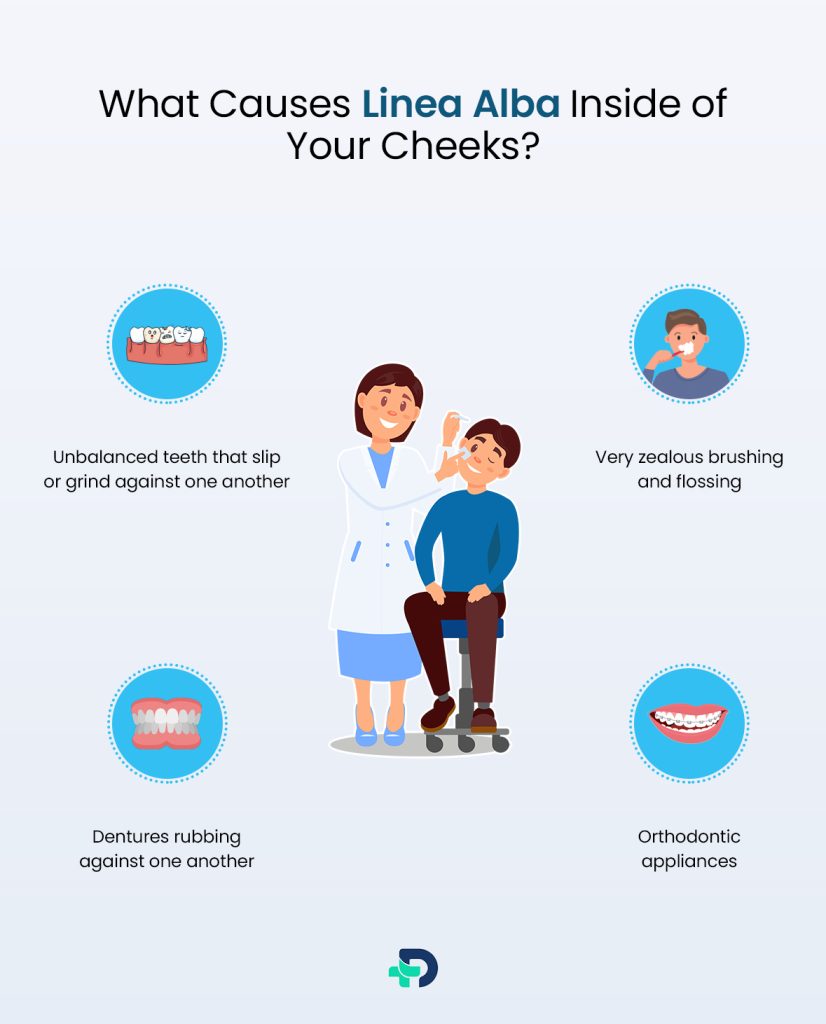Exploring The Fascinating Linea Alba Cheek: Symptoms & Management

- Mouth Lesions
- 10 Oct 2023
Introduction
Linea Alba Cheek
Buccal mucosa, the inside tissue of the cheek, hardens when you have a disorder called Linea alba. The formation of keratin, the substance that causes this illness, results in the pink tissue of your cheek developing a white ridge. The primary cause of this illness is contact between the cheeks’ soft tissue and teeth which does not cause any significant pain or discomfort, but must be maintained to prevent the issue from thickening over time. 1 Introduction | Researched based study from Index Copernicus

Causes

What Causes Linea Alba Inside of Your Cheeks?
Typically, buccal mucosa, also known as the lining of your cheek, is the source of this chronic (ongoing) irritation which causes irritation in the mouth. It can also be caused by other sources of friction in the mouth that includes;
- Unbalanced teeth that slip or grind against one another
- Orthodontic appliances
- Very zealous brushing and flossing
- Dentures rubbing against one another. 2 Causes| Researched based study from National Institutes of Health
Symptoms
Linea Alba Symptoms
- Linea alba is a condition that frequently manifests as a white, horizontal line that runs from the occlusal plane across the inside of your cheek.
- The occlusal plane, which stretches from your incisors to your molars, is the region where your upper teeth touch your lower teeth.
- If you don’t actively seek it out or until a dentist discovers it during an examination, you might not even be aware that you have the condition. 2 Symptoms| Researched based study from National Institutes of Health
Is Linea alba a common finding in the mouth?
- Yes, occurrence of Linea alba is common since it occurs as a typical feature that is most likely brought on by trauma from sucking on the teeth’s facial surfaces or from pressure, or frictional irritation.
- People who chew tobacco may also develop it, which raises the possibility that it is misinterpreted for a premalignant lesion that needs to be treated or managed at the earliest. 2 Symptoms| Researched based study from National Institutes of Health
Complications
When to Consult a Doctor?
- By itself, Linea alba doesn’t need any extra care. You can address the issue and see if it helps if you are aware that you grind your teeth or if your dentures don’t fit properly.
- But if you start to have other symptoms, such as jaw discomfort or numbness, bleeding, or sores that won’t heal, let your doctor know right soon.
- Consult a physician if you are a tobacco smoker and discover a strange lesion on your face or inside of your lip.
Your doctor may examine the findings and suggest test listed below to confirm the diagnosis which includes:
- Imaging tests such as a CT or MRI scan
- Blood tests
- Biopsy.
When you notice symptoms, don’t ignore them because getting the right diagnosis is essential for getting treatment and managing conditions such as Linea alba in a timely manner. 2 Complications| Researched based study from National Institutes of Health
Can Linea alba cause mouth cancer?
- Early malignancies and premalignant lesions are frequently asymptomatic, hence a comprehensive soft tissue examination by a dentist is necessary to identify them.
- The lips, cheek, tongue, floor of the mouth, the gums, the roof of the mouth, and oropharynx (back of the throat) are examined during this procedure.
- The majority of oral lesions are traumatic in origin and have no chance of developing into cancer, including Linea alba, which may resemble malignant lesions in appearance but has no possibility of turning into a cancerous lesion. 3 Complications| Researched based study from The American Academy of Oral Medicine
Should I be worried about Linea alba?
- Linea alba is mostly unharmful and will disappear on its own.
- You should consult a dentist to rule out other causes if Linea alba persists for more than a week or two, and it is accompanied by additional symptoms such as redness, swelling, and/or soreness. 2 Complications| Researched based study from National Institutes of Health
How long does Linea alba last?
- Linea alba usually causes no harm and disappears on its own. However, you should visit a dentist to rule out other causes if Linea alba lasts more than a week or two, and is accompanied by additional symptoms such as discomfort, swelling, and/or redness.2 Complications| Researched based study from National Institutes of Health
Management
Treatment for Linea Alba in the Mouth
- Make an appointment with your dentist if you see a lesion in your mouth. They can assess whether the lesion is merely the result of friction—such as cheek biting—or whether it has more serious repercussions.
- Even though Linea alba isn’t harmful, it resembles leukoplakia, which can be a sign of oral cancer even if it’s not.
- Your dentist will make an effort to determine and treat the source of the friction, such as suggesting a mouthguard for patients who clench or grind their teeth at night. Similar to this, your dentist may alter your appliance to treat the cheek lesion if your braces or dentures rub against your cheek.
- If you habitually bite or chew on the inside of your cheek, you should attempt to change this behaviour. If you nip at your cheeks when you’re anxious, consider finding a therapist or practising breathing exercises as a way to control your worry.
- No matter the course of treatment, your dentist will certainly want to examine the results during a subsequent session. 2 Treatment| Researched based study from National Institutes of Health
Home Remedies
Home Remedies for Linea Alba in the Mouth
- In most cases, Linea alba in the mouth is harmless and goes away without any help.
- To ease the discomfort and irritation brought on by the condition, practise regular brushing and flossing and rinse your mouth with salt water.
- Topical Linea alba cream, which is easily accessible over-the-counter, can also be used to ease discomfort caused by the condition. 2 Home Remedies| Researched based study from National Institutes of Health
Takeaway
Linea Alba in the Mouth – Consult a Dentist
- Typically, the Linea alba is bilateral.
- It is only present in dentulous places (i.e., if teeth are missing, there won’t be a line, unless a denture is worn in those areas)
- It appears as an asymptomatic, Linear elevation at the level of the occlusal line of the teeth that is whitish in colour
- The condition is usually not harmful, but you should still get it examined by a dentist to make sure the line is genuinely Linea Alba. 1 Takeaway | Researched based study from Index Copernicus , 2 Takeaway| Researched based study from National Institutes of Health
Any feedback on this article?
 This Articles content was accurate
This Articles content was accurate Very Informative Article
Very Informative Article I have a question or a comment
I have a question or a comment
 This article contains inaccurate content
This article contains inaccurate content This article was not helpful
This article was not helpful I have a question or a comment
I have a question or a comment
We appreciate your helpful feedback!
Checkout our social pages
References
-
Index Copernicus
Introduction | Takeaway
-
National Institutes of Health
Causes | Symptoms | Complications | Treatment | Home Remedies | Takeaway
-
The American Academy of Oral Medicine
Complications






































